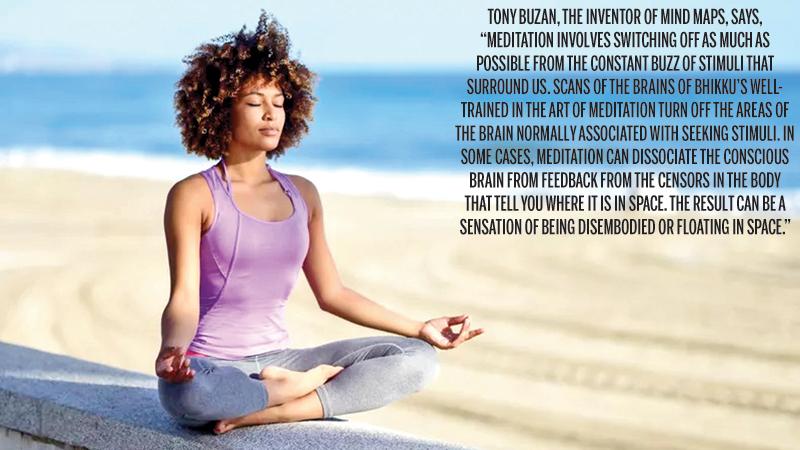
The word ‘meditation’ connotes various images. You can visualise a bhikku meditating in a cave or at the foot of shady tree. You can also imagine a group of elderly people meditating at a temple. Originally meditation was closely associated with Buddhism. However, meditation has gone beyond religious boundaries. Today meditation is not an exotic or difficult practice that requires repeating a set of words or gazing at a particular object or sitting in the lotus position.
Meditation can be practised while sitting in a comfortable position anywhere you like. Some people find it difficult to sit in a cross-legged posture on the floor. There are many other options for a person to practise meditation. You can meditate lying down on your back or simply sitting in a straight-backed chair. However, there are certain preliminaries. You have to straighten your spine and imagine that you are supported by a string hanging from the ceiling.
In meditation, proper breathing is a prerequisite. Take a deep breath through your nose so that your lungs are full of air. To do this you have to expand your chest and abdomen muscles. Then you need something to focus on. For this you can use a candle flame, a flower or even a picture. While focusing on the object breathe in and out slowly.
Difficult situation
A person in good health may wonder why he should meditate. Even such a person may have to face difficult situations. On such occasions tell yourself that it is not necessary to get stressed. Just start breathing slowly and try to concentrate on a particular object. It will calm you down giving you time to focus on the task at hand. In a stressful situation meditation will keep you going. It will help you to become a calm and confident person.
Today firefighters, auto-assembly workers, doctors and nurses practise this ancient art to relieve stress. Transcendental Meditation (TM) is just one of several techniques practised widely in the United States. In fact, its National Institutes of Health have allocated a grant of $8 million to the College of Maharishi Vedic Medicine in Fairfield to study natural healing methods including TM.
Apart from tackling stress, meditation will help you to manage heart diseases, migraines, high blood pressure and cope with pain in cancer treatment. Meditation attracted the attention of the scientific community in the United States in the 1970s. Herbert Benson, a cardiologist at the Harvard Medical School directed heart patients to meditate. After a session meditation he noted that the patients’ blood pressure had dropped. He was so impressed with meditation that he published his findings in ‘The Relaxation Response’ which became a bestseller. Later he set up the Mind / Body Medical Institute in Boston to promote meditation. He says meditation helps to decrease anxious thoughts and stress hormones.
Meditation and surgery
Alice Domar, a psychologist at Harvard Medical School, taught meditation methods to patients undergoing surgery. She says even a session of two-minute meditation helped patients to cope with pain. With such patients surgery took less time as their blood pressure was lower. Those who do multitasking are subject to stress. Marsha Manning who was doing a multitasking job at General Motors was subject to constant stress. She studied how to meditate and even taught the benefits of meditation to other employees.
With proper meditation you can concentrate on any task effectively. Your concentration powers will make you a productive worker. Even in Sri Lanka Mindful Meditation is practised in certain organisations including state universities. It is another technique of meditation that relies heavily on what is happening in the present moment. Those who are worried about the past events should practise Mindful Medication.
In Sri Lanka group meditation is quite popular. On Poya days you can see young and elderly people meditating at temples and other places. They are usually guided by an experienced bhikku. All of us may not be in a position to take part in a group meditation. Therefore as individuals you can practise meditation at your own place. The main purpose of meditation is to calm down your stress levels. A person who knows how to meditate will not get rattled by extraneous events. If you really care for your physical and mental health, you can meditate anywhere anytime.
Floating in space
Tony Buzan, the inventor of Mind Maps, says, “Meditation involves switching off as much as possible from the constant buzz of stimuli that surround us. Scans of the brains of Buddhist monks well-trained in the art of meditation turn off the areas of the brain normally associated with seeking stimuli. In some cases, meditation can dissociate the conscious brain from feedback from the censors in the body that tell you where it is in space. The result can be a sensation of being disembodied or floating in space.”
The biggest impediment to continued meditative practice is the lack of time. We have many responsibilities in the workplace and at home and we hardly find time for meditation. If you are unable to devote huge chunks of time each day for meditation spend at least a few minutes to practise meditation. Some people may be able to meditate for 30 minutes a day. Others may meditate only for a couple of minutes. Even if you are down near the end of the spectrum, your practice can have depth. If you keep in mind the basic elements of meditation, it will be an achievement.
The million-dollar question is whether meditation will make you happy. When you meditate you do not worry about the quantity of happiness. Be mindful of the quality of happiness. If you meditate meaningfully, you will get a clear view of life. That is a real bonus in addition to being able to relieve stress and boredom. Happiness is a state of the mind. Through meditation you begin to live a stress-free life. That is the first step to happiness.
